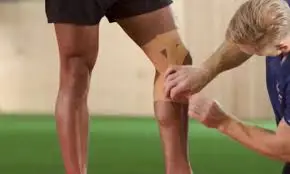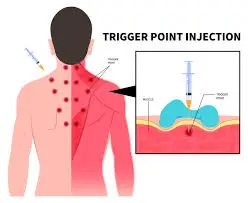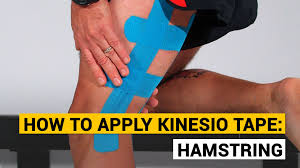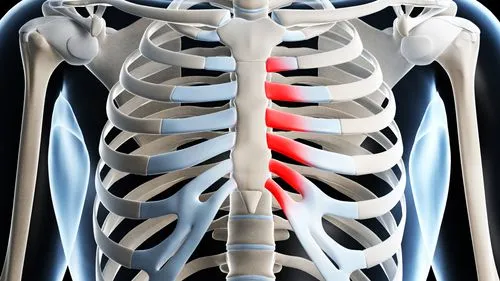Rigid Taping Techniques
What Is Rigid Tape?
Rigid taping is a widely used method in sports medicine and physiotherapy aimed at supporting and stabilizing joints and soft tissues during physical activity. Unlike elastic taping, which allows for a degree of movement, rigid taping restricts movement to provide maximum stability.
This technique is particularly beneficial for managing acute injuries, preventing re-injury, and providing structural support to weak or compromised areas of the body.
Additionally, it aids in stabilizing the ligaments and joints during vigorous exercise, such as training and sporting events. This tap tape is frequently used for rehabilitation but also acts as a safeguard.
Sports medical tape of this kind typically comes in white or skin-colored color and is frequently self-adhesive. It is strong and non-elastic, with sharp edges that make tearing simple. Sizes for these tapes include 50mm, 38mm, 25mm, and 12.5mm.
What Differentiates Kinesiology Tape from Rigid Tape?
These two serve nearly identical functions, particularly in sports medicine. Both of them:
- Reduce inflammation
- Reduce pain
- Support injured parts of the body
- Assist in healing
- Despite their similarities, there are two main areas in which they differ.
To begin with, kinesiology tape encourages movement while stiff tape restricts it. Both serve almost the same function, but the firm tape has more support for its work. Conversely, KT tape has greater flexibility.
Second, joints are usually the most benefitted by stiff tape. Kinesiology tape primarily provides muscle support.
What Should You Know Before Using Rigid Tape?
You should know certain things about the stiff tape before applying it to any part of your body. Wearing stiff tape, for example, is safe for extended periods. This is because the zinc oxide-based join that is frequently used for this tape has a two-day maximum expiration date. Even so, removing the tape after a few hours rather than several days is still advised.
Regarding compatibility, zinc oxide glue is not appropriate for all skin types. Start by applying tiny areas of your skin. Assess your skin’s response to the tape before completing the strapping.
For the best results, it’s always advisable to speak with a certified physical therapist. These medical professionals are aware of the ideal duration for which to apply tape to your body. Depending on the type of injury and how long it takes for recovery, the duration will change.
Can You Use Rigid Tape in the Shower?
Rigid sports tape comes in a variety of varieties designed to help sweat evaporate. While perspiring, it might not be an issue, but while taking a shower, it becomes problematic.
It is not a good idea to get your strapping wet. Water causes the adhesive to wear off, which could lessen the tape’s effectiveness. To promote healing and ensure that the tape stays on, injuries should constantly be kept clean and moist.
Can You Use Rigid Tape While Sleeping?
This tape’s main purpose is to restrict movement. It is airtight and rigid. It’s meant to remain stationary. You are therefore unable to sleep with this sports medicine tape on.
The substance of the tape will make it difficult and uncomfortable to sleep. Wearing them in bed will make you sweat because it’s hot. Not being able to move around freely will also keep you from sleeping through the night. This suggests that it is neither advisable or healthful to sleep with stiff tape.
The Benefits of Rigid Taping
You might not believe that rigid taping is as beneficial for your injuries and general health as you might think. Here are all the advantages of stiff tape for when you’re awake and not in the shower:
Injury Prevention and Joint Stability
Rigid taping offers several benefits, chief among them the prevention of injuries and the stabilization of joints. Your base is the tape, which limits excessive movement. It lessens the possibility of sprains, strains, and ligament injury as a result.
For this reason, athletes in high-impact sports like football, basketball, and hockey benefit from stiff tape. It protects delicate regions from sudden twists and hyperextensions by strengthening areas like the ankles, knees, and wrists.
Support for Weak or Injured Muscles
Rigid tape is a fantastic aid for people healing from weakness and even muscular injuries. The tape assists in off-loading the injured muscles, minimizing strain, and accelerating recovery by offering external support.
If you have a history of muscular injuries, mainly from sports, rigid tape can be quite beneficial. Athletes who use rigid taping will be able to get back to training and maybe play their current sport sooner.
Alleviating Pain
Rigid taping can be a lifesaver for people who are in pain as a result of overuse or joint injuries. By stabilizing the affected area, it relieves pressure on the tissues that have been damaged. This reduces the amount of pain experienced during any kind of physical exercise.
Athletes can maintain and improve their performance while guaranteeing their recovery because of the tape’s pain-relieving properties.
Enhanced Proprioception and Body Awareness
Proprioception is the ability of your body to detect its position and movements in space. This is improved by rigid taping, which gives the brain sensory stimulation. It heightens one’s consciousness regarding the alignment and mechanics of their body.
Athletes will find this extremely helpful. Better control, balance, and coordination are the results of increased proprioception during physical activities and sports.
Improved Circulation and Lymphatic Drainage
Rigid taping, when done properly, can improve blood circulation, which aids in supplying vital nutrients and oxygen to tissues. In addition, it reduces inflammation and edema by enhancing lymphatic drainage. These two encourage quicker healing in the area that has been taped.
Keep in mind that this only functions in cases when the patient or athlete does not have lymphatic or venous disorders or poor blood circulation eg. deep vein thrombosis.
Postural Support and Alignment
Rigid tape, as any serious athlete knows, provides postural support throughout training and competition. Injuries can be kept in their correct alignment and kept from being overused by carefully applying tape.
Maintaining proper posture is essential for achieving maximum sports performance. Long-term musculoskeletal problems can also be avoided with the use of appropriate stiff tape.
Psychological Benefits and Confidence enhance
Rigid tape has benefits for athletes psychologically in addition to its physical ones. Their confidence could increase as a result of feeling less exposed and supported, giving them a sense of security when playing. It could enhance performance. It keeps athletes safe while enabling them to push boundaries and produce their best work.
Who Shouldn’t Use Rigid Tape?
Any athlete’s game can be enhanced by rigid tape, but not every athlete should use it. With a few exceptions, these people should find another way. If you have any of the following, see a physical therapist before applying stiff tape:
Severe Allergic Reactions to the Tape
People with a history of allergy to tape materials should avoid using stiff tape. The tape’s adhesive or backing may cause sensitivities in certain individuals. It could result in allergic responses or skin irritation.
Any allergy history must be taken into consideration before putting the tape. If there is an allergy, it’s a good idea to consider another approach.
Open Wounds
Never place rigid tape over cuts, wounds, or locations with an active skin infection. The tape may hold on to germs and other particles, slowing the body’s natural healing process and perhaps resulting in more serious issues.
Treating the wound or infection should come first in these situations. Rigid taping should be considered only after it has healed.
Pre-existing Skin Conditions
Individuals with skin disorders including psoriasis, dermatitis, or eczema should avoid using hard taping. The tape’s adhesive may worsen these disorders, which can itch, cause pain, and worsen the skin condition.
It’s crucial to make sure the skin is healthy and clear of inflammation before applying stiff tape.
Poor Blood Circulation
People with impaired circulation, such as those with diabetes or peripheral vascular disease, shouldn’t have rigid tape applied to them. The tape itself may further compromise proper blood flow to the extremities. It might make things more difficult and delay healing.
Before considering taping, a person’s circulation must be properly evaluated.
Sensory Impairments
When applying stiff tape to people who have sensory impairments, proceed with care. These include ailments like neuropathies and nerve injury. The tape may be overly tight, making it difficult for them to express any pain or pain.
Should the tape be excessively tight, more issues may arise. In situations like this, observation and regular evaluation are essential.
Immobilising Fractures or Joints
Rigid tape alone is insufficient for fractures and dislocated joints. It is not a suitable replacement for a suitable medical examination and immobilization techniques, such as casts or splints. In these cases, seeking immediate medical attention is important. To make sure you’ll employ the appropriate course of treatment.
Lymphatic or Venous Conditions
Rigid tape should not be used by those who have lymphedema, deep vein thrombosis, or other lymphatic or venous disorders. Similar to normal blood flow, the tape may obstruct the flow of fluids. Rigid tape application may potentially make the situation worse.
If someone truly does have such a disease, it’s advisable to look for a different taping option.
Compromised Sensation/s
It is strongly discouraged to use stiff tape if you suffer from conditions like neuropathies or nerve injury. In certain regions, people with these disorders may not feel anything at all, therefore the tape masks any pain or pain.
Healthcare practitioners need to apply the tape and periodically assess these patients carefully.
Tips for Applying Rigid Taping
There are various methods for using stiff tape. It is dependent upon the sport or even the location of the injury. The general guidelines you should live by before, during, and following strict taping are listed below:
Preparing Your Skin
- If possible, shave the region of the skin where the sports tape will be applied. The results will be better if you use an electric or traditional razor to shave. Before using the tape, it should be completed at least 12 hours beforehand.
- To remove extra oil from your skin, gently clean the area with a dry towel. This will ensure that the tape stays in place.
- Apply bandages to any cuts or injured flesh.
- Put on an under wrap to protect the skin from irritation or even rashes.
Applying the Tape
- For best effects, use athletic tape on joints that are at rest.
- Don’t overextend your muscles when wrapping the tape over them. In doing so, the tape’s hold will be lost.
- To ensure that the tape goes across your skin smoothly, only apply it in one direction.
- Gently overlap the tape with itself. The tape grip will improve with this method.
Checking the Strapping
- In order to determine how tight the tape should be, slightly flex your muscles. It won’t be able to protect the joints and limbs in the proper posture if it is positioned too loosely.
- If the skin gets tingly or numb, remove the strapping tape and reapply with less strain. Since this will slow down blood circulation, it shouldn’t be overly tight.
- When taping, try to use the least amount of tape. Use just enough tape to avoid immobilizing muscles. Recall that the quantity of tape required still depends on how much assistance you require.
Removing the Tape When Done
- As soon as your training or game for the day is over, remove the tape. Rigid tape strapping should only be used for a few hours at a time.
- With scissors, cut the tape short. It will facilitate taking off the tape. Take care when using tape scissors close to the skin.
- After cutting the tape apart, carefully remove it from the skin. Use tape remover, oil, alcohol, or body lotion to remove the tape gently and without leaving any marks.
Conclusion
In sports and rehabilitation, rigid tape has emerged as an essential and priceless aid. The tape’s many benefits and ongoing application in sports medicine attest to its importance to experts like sportsmen. These folks strive to perform better and accomplish their objectives in a safe and efficient manner. All because of the stiff tape.
With stiff taping as their trusted ally, these athletes may confidently accomplish their objectives and succeed in their chosen fields. In the end, using stiff tape is definitely advantageous. It is meant for those who wish to strike a compromise between the demands of comfort, security, and safety and optimum performance.
FAQs
What is rigid taping used for?
The joints that are most commonly affected include the knees, elbows, wrists, ankles, and shoulders. By restricting movement, the tape serves to physically support the joint. The tape is mostly utilized when a joint strain, like an ankle sprain, prevents you from returning to sports.
What is the difference between Kinesio taping and rigid taping?
Usually, rigid tape is applied to the affected area to offer stability and support. Kinesio tape, as contrast to rigid tape, is put in a particular pattern based on the injury or the goal of extra help behavior in order to improve joint and muscle proprioception, expand range of motion, and improve performance.
What is rigid sports tape?
Restricting the movement of ligaments, tendons, and joints is the main goal of the tape in order to avoid damage or re-injury under high-stress situations. Because it is constructed with a durable rayon backing and a rubber zinc oxide adhesive mass, a significant degree of support may be provided.
How is physical therapy using stiff taping?
muscular Protection: It provides compression and lessens muscular vibration during activity when applied to muscles that are prone to strains or overuse problems. Postural Correction: By giving weaker or tired muscles an external support, rigid tape can help preserve good alignment and posture.
Can you sleep with rigid strapping tape on?
It varies. While Kinesio tape can be used to wrap your ankle while you sleep, athletic tape should not be used for this purpose. Athletic tape is stiff and won’t provide you with much flexibility. Wearing athletic tape for extended periods of time is not recommended.
Reference
- Mehta, A., & Mehta, A. (2022, August 2). Rigid Taping techniques – Samarpan Physio. Samarpan Physiotherapy Clinic. https://samarpanphysioclinic.com/rigid-taping-injury/
- A. (2023, September 13). Rigid Tape: A Comprehensive Guide. GulfPhysio – UAE’s Online Physiotherapy Store. https://www.gulfphysio.com/injuries-and-treatments/rigid-tape-a-comprehensive-guide/







